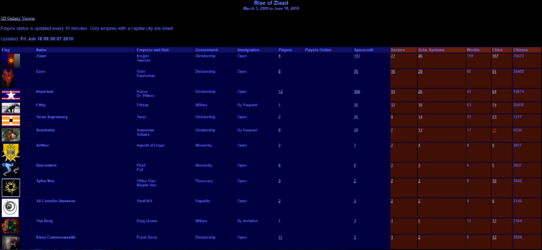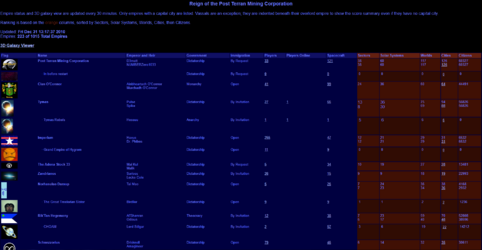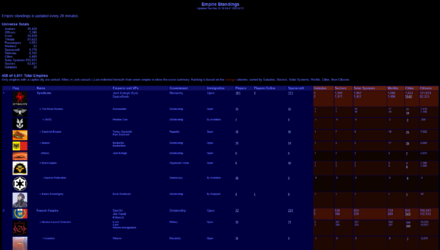Empire Standings: Difference between revisions
mNo edit summary |
(Turns out it used all orange columns for ranking during Universe 3 so nvm) |
||
| (4 intermediate revisions by 2 users not shown) | |||
| Line 1: | Line 1: | ||
{{RemovedFeature}} | {{RemovedFeature}} | ||
During the [[MMO]], '''Empire Standings''' were available on the main ''Hazeron'' website. It was a leaderboard of ranked empires, and displayed information such as their total colonized [[sector]]s, solar systems, worlds, cities, along with their government types, spacecraft, players, loyal citizen counts, and more. It also displayed [[universe]] total statistics (including unranked empires), such as the total amount of [[avatar]]s, officers, cities, explored solar systems, etc. An empire needed to have an empire capital city in order to be considered a "Ranked Empire" and tallied on the [https://www.hazeron.com/EmpireStandings/ Empire Standings] page of the main website. From 2017 onwards, empires would also need cities in at least two solar systems to be ranked. | During the [[MMO]], '''Empire Standings''' were available on the main ''Hazeron'' website. It was a leaderboard of ranked empires, and displayed information such as their total colonized [[sector]]s, solar systems, worlds, cities, along with their government types, spacecraft, players, loyal citizen counts, and more. It also displayed [[universe]] total statistics (including unranked empires), such as the total amount of [[avatar]]s, officers, cities, explored solar systems, etc. An empire needed to have an empire capital city in order to be considered a "Ranked Empire" and tallied on the [https://www.hazeron.com/EmpireStandings/ Empire Standings] page of the main website. From 2017 onwards, empires would also need cities in at least two solar systems to be ranked. The ''winner'' of each [[:Category:History|universe]] was considered the empire at the top #1 spot when the universe ended. | ||
Allies and vassals would be indented under their parent empire with <code>+</code> and <code>-</code> symbols, respectively. These empires would contribute their score to the parent empire, helping it increase in ranking. For the parent empire, their total loyal citizens would be shown first, and then the loyal citizens provided solely by the parent empire itself would be shown. | |||
There were separate standings for the ''conflict'' and ''neutral'' zones of the [[universe]]. These were separated due to the no-PvP nature of the neutral zone. | There were separate standings for the ''conflict'' and ''neutral'' zones of the [[universe]]. These were separated due to the no-PvP nature of the neutral zone. | ||
Initially, the page ranked empires using all of the orange columns, going from sectors to loyal citizens. This was later changed to only use '''loyal''' citizen counts. This would be changed again to use [[world]]s in August 2018. Later, in December 2019, it would be changed again to only use solar systems. | Initially, the page ranked empires using all of the orange columns, going from sectors to loyal citizens. This was later changed to only use '''loyal''' citizen counts. This would be changed again to use [[world]]s in August 2018. Later, in December 2019, it would be changed again to only use solar systems. Around this time, all other empire-specific information was also removed entirely, such as sector, solar system, world and city counts, along with spacecraft, immigration policy, and government type information. | ||
{| | {| | ||
| Line 15: | Line 13: | ||
|[[File:FinalU3Standings.png|thumb|none|x250px|The final standings of [[:Category:Universe_3|universe 3]]]] | |[[File:FinalU3Standings.png|thumb|none|x250px|The final standings of [[:Category:Universe_3|universe 3]]]] | ||
|} | |} | ||
==Galaxy Viewer== | |||
Before 2013, the page also contained a link to the 3D Galaxy Viewer. This was the predecessor of the [[Star Map]]. It showed the location of every empire in the game, from a source file named <code>empiredata.txt</code>. Its removal in 2012 caused some drama due to claims that it could be used to prevent griefing. | |||
[[Category:History]] | [[Category:History]] | ||
Latest revision as of 23:10, 14 April 2024
| This content no longer exists in the game. This page is kept for historical purposes. |
During the MMO, Empire Standings were available on the main Hazeron website. It was a leaderboard of ranked empires, and displayed information such as their total colonized sectors, solar systems, worlds, cities, along with their government types, spacecraft, players, loyal citizen counts, and more. It also displayed universe total statistics (including unranked empires), such as the total amount of avatars, officers, cities, explored solar systems, etc. An empire needed to have an empire capital city in order to be considered a "Ranked Empire" and tallied on the Empire Standings page of the main website. From 2017 onwards, empires would also need cities in at least two solar systems to be ranked. The winner of each universe was considered the empire at the top #1 spot when the universe ended.
Allies and vassals would be indented under their parent empire with + and - symbols, respectively. These empires would contribute their score to the parent empire, helping it increase in ranking. For the parent empire, their total loyal citizens would be shown first, and then the loyal citizens provided solely by the parent empire itself would be shown.
There were separate standings for the conflict and neutral zones of the universe. These were separated due to the no-PvP nature of the neutral zone.
Initially, the page ranked empires using all of the orange columns, going from sectors to loyal citizens. This was later changed to only use loyal citizen counts. This would be changed again to use worlds in August 2018. Later, in December 2019, it would be changed again to only use solar systems. Around this time, all other empire-specific information was also removed entirely, such as sector, solar system, world and city counts, along with spacecraft, immigration policy, and government type information.
 |
 |
 |
Galaxy Viewer
Before 2013, the page also contained a link to the 3D Galaxy Viewer. This was the predecessor of the Star Map. It showed the location of every empire in the game, from a source file named empiredata.txt. Its removal in 2012 caused some drama due to claims that it could be used to prevent griefing.